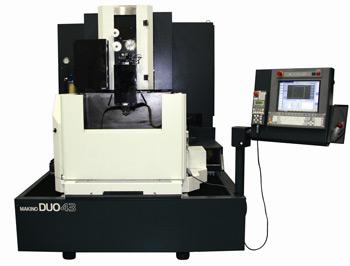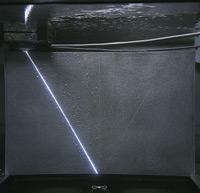- FMA
- The Fabricator
- FABTECH
- Canadian Metalworking
EDM
Understanding wire consumption
- November 1, 2009
- Article
- Metalworking
Second only to labor costs and machine payback schedules, wire consumption is the most expensive facet of running a wire EDM machine.
Controlling the cost of this consumable item, while dependent on the application, is the best way to control the cost of your EDM process as a whole.
The number of choices that exist when selecting an EDM wire are nearly endless, and each affects cost. These costs not only vary by the prevailing metal rates, but also by distributor, brand, diameter, core, coating, quantity ordered, stock on hand, and geographic region.
And, in some applications, a better wire can be used that will speed up burns while reducing costs. These EDM wires with special coatings can maximize cut speeds, increase productivity, and save time and money.
Many applications can be burned faster with these coated wires and also still fall within the needed specifications for accuracies, tolerances, and finishes. Even though the coated wires can cost two to three times what brass wire does, they can actually produce more revenue by reducing the time the part spends on the machine.
The EDM process also may benefit from a two-wire system, which uses a large wire for rough cutting and a smaller, more expensive wire to complete the details of a finishing cut.
Gauging Costs
For many shop owners, estimating costs to quote jobs correctly is akin to having a root canal. They know it has to be done, but that doesn’t mean they have to like it.
With the wire EDM process, reducing the amount of wire consumed can directly affect the cost of the final part.
“Many modern wire EDMs have built-in job estimators,” said Jeff Kiszonas, EDM product manager for Makino. “Once the machine knows the wire diameter, cost of wire, and part geometry and thickness, the estimators can quickly calculate how much time and wire will be required for this job.”
The worst-case scenario in using these calculators is that the machine will produce estimated cutting speeds for each E-code used in a particular program. Then, from these estimates, the operator must calculate the amount of wire that will be used over a particular geometry length for each pass and multiply that result by the cost per unit of the wire to get the final number.
According to Kiszonas, when using 0.010 and 0.012-in. wire, Makino wire EDMs will feed at a rate of about 0.6 lbs per hour. This feed rate results from the use of large, linear motion components; a proprietary wire drive system; and the company’s BellyWizard technology, which was created to reduce the “bowing” effect in long, vertical cuts.
“By using a proprietary gap and servo control and building a very stable, accurate platform, we are able to feed the wire at a rate of 20 percent to almost 60 percent slower than other machines while producing equal or better parts in equal or less time,” said Kiszonas.
The math is simple: by slowing the wire feed rate, less wire is consumed.
If a machine can use less wire, and have longer intervals between needed maintenance, the cost per hour of running that machine will be reduced.
However in many cases, such as the cutting of tall parts, the wire will erode as it cuts through the part. Faster wire feeds result in less wear on the wire from the top to the bottom of the part, thus putting less taper in the part.
“If cutting speed is increased, wire feed rate will need to be increased as well,” said Kiszonas. “If wire feed rates are reduced and cutting speeds remain the same, there is a much higher chance of problems with surface finish, accuracy, and more wire breaks.”
There are other problems associated with higher cutting speeds, however.
Higher cutting speeds will increase the material removal rates during the cutting process. However, higher material removal rates will also reduce the life of the machine’s filters.
“If you are putting more debris in the dielectric [fluid] in a shorter amount of time, the filters will trap the same amount of debris in fewer hours,” explained Kiszonas.
EDM Maintenance
While guides will suffer no ill effects and contacts will not see a significant amount of wear, filters are critical because the faster the cut, the more material is removed in a shorter period of time.
“If your filter system is of poor quality, you will not be able to run the machine unattended at high speeds,” added Gisbert Ledvon, business development manager for GF AgieCharmilles.
A round guide is used for one wire diameter, whereas a V-type guide can accommodate multiple wire diameters because it is not closed like the round guide. If you plan to use multiple wire diameters, guide change time must be planned.
Roughing/Finishing
Feeding wire more slowly is not the only way to reduce wire consumption. Taking fewer passes to complete a job also will use less wire.
After the roughing pass, a belly or a bow can be produced, especially in tall parts. This means that more skims will be required to remove that material and finish the part to the correct dimensions with the correct finish and the correct straightness.
If the roughing pass is not done correctly, more wire is consumed than is necessary since a second pass must be performed.
During these skims, machine offsets also are critical. During the roughing pass, the EDM will intentionally leave stock to allow the finish passes to correct geometry, improve accuracy, and improve the surface finish. If the offsets are not perfect, then the machine may have to slow down during the skimming passes. This slowing will cause the machine to consume more wire than necessary.
“The accuracy of the rough cut affects the speed of the finishing passes and, as a result, overall wire consumption,” said Ledvon. “Also, the better the surface quality after the rough cut, the less time and wire is used on the finish cuts.”
Down to the Wire
Multiple EDM wire cores and wire coatings have been developed to improve speed, surface finish, and taper machining accuracy and finish.
However, according to Anthony Caruso, head of Sodick’s Hightech consumables division, if brass wire were free, customers could still save money by running coated EDM wires because of the time savings achieved.
“Brass wires are the least expensive wires to purchase up front, but achieve the slowest cutting speeds,” said Caruso. “Coated wires are more expensive to purchase up front, [but] they offer increased speed, which more than offsets the price of the wire.”
Brass wires still are the most common EDM wires in the market because most EDM manufacturers have not fine-tuned the machine’s power settings for use with coated EDM wires at least not as much as they have with brass.
“In actuality, coated EDM wires are far more economical to run versus brass,” said Caruso.
Also, if the EDM operator has a good deal of EDM knowledge, then the power settings can be modified manually to achieve better cutting conditions.
For jobs that need to be processed quickly, the EDM machine should run with a zinc-coated EDM wire.
“Zinc-coated EDM wires will increase speed and finish the jobs faster,” Caruso said. “A 10-hour job will most likely only take eight hours to machine using a zinc-coated EDM wire.”
In addition, soft, coated EDM wires are advantageous when machining tapers – an operation during which flushing is severely diminished.
“By running a soft, coated wire on high-taper machining, customers will experience more accurate taper angles and better surface finishes while eliminating lines in the part’s surface,” Caruso said.
To run unattended for long hours, today’s EDM machines make use of automatic wire threading devices.
“Automatic EDM wire threaders are essential in today’s market. Nearly every EDM machine available has a threader as standard equipment,” said Caruso.
These threading systems allow the user to machine multiple locations without manual operator intervention. The threader also will correct situations in which the wire breaks during an EDM operation.
“Without a threader, the EDM machine counts on the operator for much more,” said Caruso.
For more information, visit www.makino.com, www.gfac.com/us, and www.sodick.com.
Related Companies
subscribe now


Keep up to date with the latest news, events, and technology for all things metal from our pair of monthly magazines written specifically for Canadian manufacturers!
Start Your Free Subscription- Trending Articles
- Industry Events
MME Saskatoon
- May 28, 2024
- Saskatoon, SK Canada
CME's Health & Safety Symposium for Manufacturers
- May 29, 2024
- Mississauga, ON Canada
DiPaolo Machine Tools Open House 2024
- June 4 - 5, 2024
- Mississauga, ON Canada
FABTECH Canada
- June 11 - 13, 2024
- Toronto, ON Canada
Zoller Open House & Technology Days 2024
- June 12 - 13, 2024
- Ann Arbor, MI

















